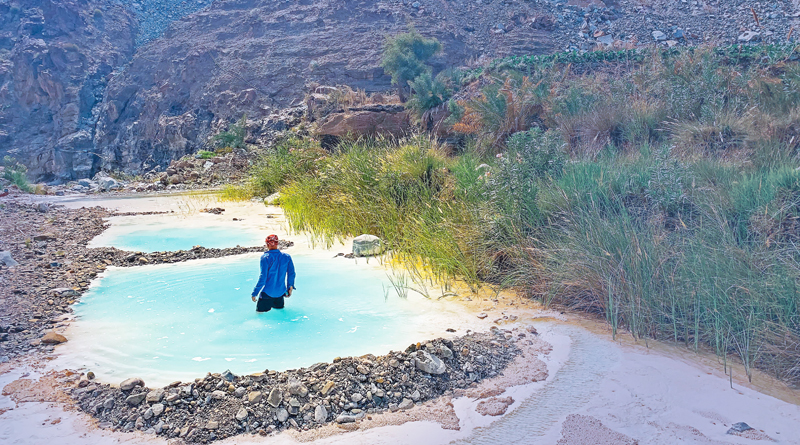






Deep into the heart of Al Batinah Governorate, in the mountainous area of Liwa, is a small village that has thrived for generations. Bat Village has been self-sufficient all these years and thanks to rich, fertile lands and abundant source of water, they managed to farm produce where farmers and their families get their daily needs with extra harvests that usually make their way into the nearby markets.
Not to be confused with another Bat area located in Ibri where the necropolis can be found, it is seldom that people venture to this part of Oman. Who would ever think that the dry, rocky mountains would be a secret hiding place of a beautiful, serene oasis where, daily, men ride on their donkeys to go to their small yet sufficiently green gardens?
It is these gardens planted with tomatoes, bottle gourd, squash and root crops that would take your attention first. Nestled amidst towering date palms, the soil is well-watered resulting in healthy, beautiful crops ready for the picking.
Not far from the village is the prize possession of the whole Liwa area. While surely the wadi may have its local name (Google map labels it as Wadi Fazah], Wadi Bat is the easiest to remember.
Discovering a hidden treasure
If residents of Oman will be asked of where beautiful wadis can be found, their immediate reaction would be to point you in the southeast direction of Oman, particularly in the Al Sharqiyah governorate.
It is here that Wadi Shab, Wadi Tiwi and Wadi Al Arbeieen had found their home. No one will really mention Al Batinah or Liwa since the three-hour drive feels like too much of a waste of time to experience something that the same satisfaction can be had in other nearer wadis.
“Not a lot of people knew about this place. We only heard of Wadi Bat from someone who lives in the area and even that came out like a gossip. No one really knew if it was worth the long drive,” shared local explorer and founder of interest group Oman Outdoor Adventure, Ahmed al Jaabri.
“Having some free time on our hands, we organised a search committee composed of a small group of people. We met up with Khalil al Balushi, a resident of Al Batinah, to guide us towards this wadi,” he shared.
“Wadi Bat has its own personality. It combines both the mesmerising beauty of Wadi al Hoqeen and the challenging trek of Wadi Tiwi in Mibam Village,” he said.
The nearly 5kms expanse of Wadi Bat offers different sceneries. The terraced pools which probably got their snowy white colour sediments from calcium carbonite instead of sulphur at the mouth of the wadi were the perfect welcome to any tired explorer. The reflection of the blue sky helped the water on these pools to appear azure blue — making it a very Instagrammable view.
A few minutes of hike led to a small waterfall about eight feet tall which poured into a deep, enticing pool of bluish water. Farther down, one has to hold onto rocks to get to a shallow cave formed under the massive cliffs where another pool is waiting.
The next few kilometres are peppered with emerald pools, fern-filled water cascades and a beautiful view of the sky framed by the two massive cliffs on both sides.
“We didn’t expect we’d find something this beautiful hidden here in Liwa. With the majority of the people living in the area without access to technology, it is to be expected,” Al Jaabri said.
Responsible, sustainable tourism
Al Jaabri shared that he was conflicted in sharing the location of Wadi Bat because based on experience, places like this usually get trampled on by irresponsible travellers.
“We’ve seen it happen before. When Wadi Mibam and Ain Sahban started gaining popularity, the amount of trash and the desecration of the natural beauty of these places was heart-breaking and disappointing,” he said.
“These are hard to visit places. There is no authority supervision on these areas so it’s up to the visitors to look out for themselves and make sure they don’t leave their trash behind,” he said.
“I hope when they do go to Wadi Bat, they will be more responsible and ensure that the beauty of the place will be preserved for others to see,” he advocated.
He added, “People will be passing through gardens and plantations. People must respect the villagers and their farms and gardens. Anyone who goes to Wadi Bat must refrain from picking fruits and vegetables from the gardens as these are private properties and should not be violated.”
How to get there
Located about 230km from Muscat, the trip going to Wadi Bat can take up to three hours. From Muscat, take the road going to Suhar and continue driving the main road until you reach Liwa. When in Liwa, punch in the coordinates 24°30’44.0”N 56°27’43.0”E on the map [Google Map labels the wadi as Wadi Fazah].
FAQs
Do we need to use four-wheel drives? This is located in a mountainous area with rough roads and steep incline. Four-wheel drives are a must.
Is it safe for children to travel here? A destination like this comes with risks. There are some areas which will be easy for kids to go to and enjoy the water but if you are planning to explore the whole wadi, we definitely will not recommend.
Oman Observer is now on the WhatsApp channel. Click here



